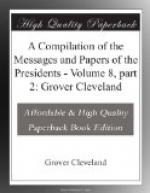ART. 26. Sailing vessels under way shall keep out of the way of sailing vessels or boats fishing with nets or lines or trawls. This rule shall not give to any vessel or boat engaged in fishing the right of obstructing a fairway used by vessels other than fishing vessels or boats.
ART. 27. In obeying and construing these rules due regard shall be had to all dangers of navigation and collision and to any special circumstances which may render a departure from the above rules necessary in order to avoid immediate danger.
SOUND SIGNALS FOR VESSELS IN SIGHT OF ONE ANOTHER.
ART. 28. The words “short blast”
used in this article shall mean a blast
of about one second’s duration.
When vessels are in sight of one another,
a steam vessel under way in
taking any course authorized or required
by these rules shall indicate
that course by the following signals on
her whistle or siren, namely:
One short blast to mean, “I am directing my course to starboard.”
Two short blasts to mean, “I am directing my course to port.”
Three short blasts to mean, “My engines are going at full speed astern.”
NO VESSEL UNDER ANY CIRCUMSTANCES TO NEGLECT PROPER PRECAUTIONS.
ART. 29. Nothing in these rules shall exonerate any vessel or the owner or master or crew thereof from the consequences of any neglect to carry lights or signals, or of any neglect to keep a proper lookout, or of the neglect of any precaution which may be required by the ordinary practice of seamen or by the special circumstances of the case.
RESERVATION OF RULES FOR HARBORS AND INLAND NAVIGATION.
ART. 30. Nothing in these rules shall
interfere with the operation of a
special rule duly made by local authority
relative to the navigation of
any harbor, river, or inland waters.
DISTRESS SIGNALS.
ART. 31. When a vessel is in distress
and requires assistance from other
vessels or from the shore, the following
shall be the signals to be used
or displayed by her either together or
separately, namely:
In the daytime—
First. A gun fired at intervals of about a minute.
Second. The international code signal of distress indicated by N.C.
Third. The distance signal, consisting
of a square flag, having either
above or below it a ball or anything resembling
a ball.
Fourth. Rockets or shells as prescribed below for use at night.
Fifth. A continuous sounding with any fog-signal apparatus.
At night—
First. A gun fired at intervals of about a minute.
Second. Flames on the vessel (as
from a burning tar barrel, oil barrel,
etc.).
Third. Rockets or shells bursting
in the air with a loud report and
throwing stars of any color or description,
fired one at a time at short
intervals.




